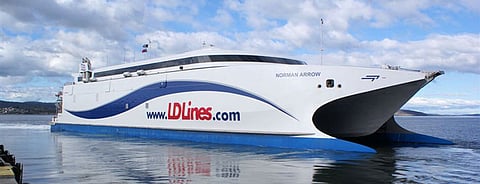

On its May 29 commencement of service on LD Lines' Dover-Boulogne route, the 'Norman Arrow' will become the largest ever fast ferry to operate on the cross channel routes between England and France and the first-ever freight carrying high-speed vessel across the Dover Straits.
She is also the world's largest diesel-powered catamaran and the first Incat 112-metre craft to operate in Europe.
At nearly 11,000 gross tonnes, the new craft is one of the largest vessels yet built by Incat, providing significantly greater sea-keeping qualities and passenger comfort than earlier generation fast ferries familiar to Dover Strait passengers, a fact echoed by one of the Masters on board for the voyage, Captain Nick Dunn.
"It can match options given by standard ferries while retaining high speeds," he said.
High speeds
The new craft will operate at speeds of 40 knots, provide a crossing time of just one hour and has capacity for 1200 passengers, 417 cars, or a combination of 195 cars and up to 30 freight vehicles.
Speaking before the vessel's departure from Hobart, Incat Australia managing director Craig Clifford said the delivery of the 'Norman Arrow' to LD Lines was a fantastic achievement for Incat and its workforce.
"It's our latest and greatest vessel. We are proud of the fact that it will be operated by one of the world's premier ferry companies," he said.
The 'Norman Arrow' has been specifically built for the European market by Incat for MGC Chartering, an Ireland-based leasing company providing a wide range of financial solutions to ferry operators including longer term bareboat charters of both new and second hand vessels. MGC has over 25 years of experience in aviation leasing and in founding MGC Chartering has adapted that very successful aviation model to the needs of the ferry market.
Range of enhancements
As one would expect, the 'Norman Arrow' has been completed with a range of enhancements derived from the operational experience of her two highly successful Japanese predecessors, 'Natchan Rera' and 'Natchan World'.
Most notable is the internal ramp system on the vessel's two vehicle decks. On the first two 112-metre vessels cars reached the full length Tier 2 upper vehicle deck via an internal ramp from Tier 1. On the latest vessel, Tier 2 is accessed via a ramp system around the forward end of the ship leaving the main deck completely clear of obstruction for high-sided vehicles. Cars move in a clockwise direction starting at the port forward end of Tier 1, turning right to traverse across the bow area and end rising facing aft on the starboard side Tier 2. This has served to increase vehicle deck capacity from 450 metres of freight at 4.35m clear height plus 193 cars at 4.5 metres length, to 567 metres of freight at 4.60 metres clear height plus 195 cars at 4.5 metres length.
If the vessel was to be filled entirely with cars then up to 417 vehicles may be carried, compared with 355 cars on the earlier vessels.
Before sailing to the English Channel, trials were conducted alongside at the Incat shipyard to test the vessel's loading capabilities. A total of 28 trucks of three types drove on and off the ship, without the need for any reversing; demonstrating turnaround efficiency and simplicity for this wide-hulled fast ferry.
| 'Norman Arrow' |
| S P E C I F I C A T I O N S |
| Type of vessel: | Catamaran Ro-Pax ferry | Main engines: | 4 x MAN 28/33D marine diesel engines, each 9,000kW |
| Class Society: | Det Norske Veritas | Transmission: | 4 x ZF60000 NR2H gearboxes |
| Certification: | DNV +1A1 HSLC R1 Car Ferry "B" EO | Propulsion: | 4 x Wärtsilä LJX 1500 waterjets configured for steering and reverse |
| Owner: | MGC Chartering, Ireland | Alternators: | 4 x MAN D 2876 LE 301/HCM 534 C 320kW (nominal) |
| Operator: | LD Lines, France | Ride control: | Maritime Dynamics active ride control system |
| Designer: | Revolution Design, Tasmania | Fuel oil: | 2 x 150,000 litres |
| Builder: | Incat Australia, Tasmania | Fuel consumption: | SFC of <190g/kWh (main engines) |
| Length overall: | 112.6 metres | Emissions: | <10g/kWh (main engines) |
| Length waterline: | 105.6 metres | Freshwater: | 2 x 5,000 litres |
| Beam of hulls: | 5.8 metres | Vehicles: | 567 truck lane metres + 195 cars or 417 cars only |
| Beam (moulded): | 30.5 metres | Passengers: | 1,200 (including crew) |
| Draught: | 3.93 metres | Sewage: | 2 x 5,000 litres |
| Speed: | 40 knots | Lube oil: | 2 x 1,000 litres |
| Maximum deadweight: | 15,000 tonnes | Genset fuel oil: | 2 x 1,240 litres |
| Gross tonnage: | 10,503 tonnes |
{artzoomin position="inside" smallImage="images/stories/poshsmall.jpg" bigImage="images/stories/poshbig.jpg"/}
